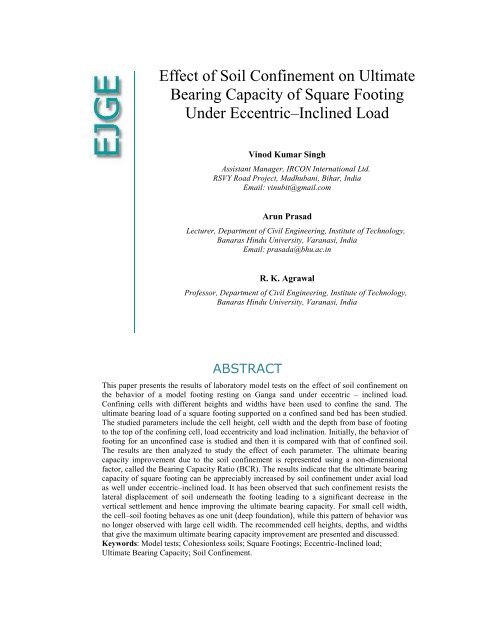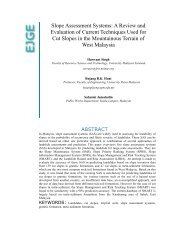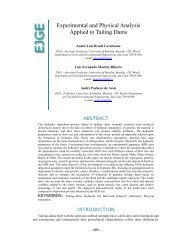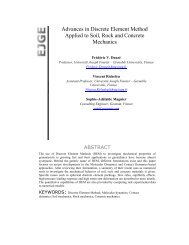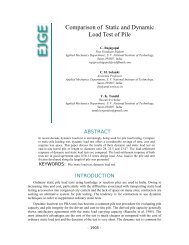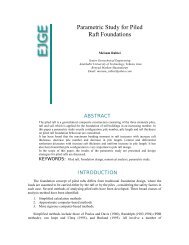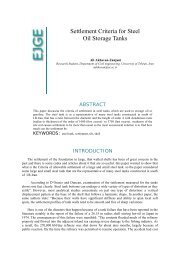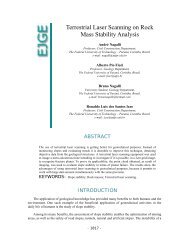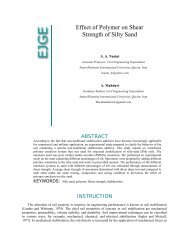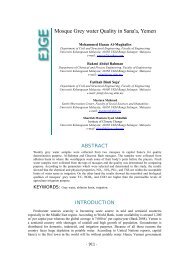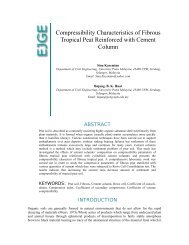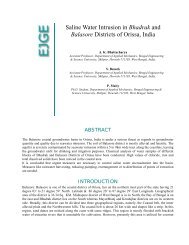Effect of Soil Confinement on Ultimate Bearing Capacity ... - Ejge.com
Effect of Soil Confinement on Ultimate Bearing Capacity ... - Ejge.com
Effect of Soil Confinement on Ultimate Bearing Capacity ... - Ejge.com
You also want an ePaper? Increase the reach of your titles
YUMPU automatically turns print PDFs into web optimized ePapers that Google loves.
<str<strong>on</strong>g>Effect</str<strong>on</strong>g> <str<strong>on</strong>g>of</str<strong>on</strong>g> <str<strong>on</strong>g>Soil</str<strong>on</strong>g> <str<strong>on</strong>g>C<strong>on</strong>finement</str<strong>on</strong>g> <strong>on</strong> <strong>Ultimate</strong><br />
<strong>Bearing</strong> <strong>Capacity</strong> <str<strong>on</strong>g>of</str<strong>on</strong>g> Square Footing<br />
Under Eccentric–Inclined Load<br />
Vinod Kumar Singh<br />
Assistant Manager, IRCON Internati<strong>on</strong>al Ltd.<br />
RSVY Road Project, Madhubani, Bihar, India<br />
Email: vinubit@gmail.<strong>com</strong><br />
Arun Prasad<br />
Lecturer, Department <str<strong>on</strong>g>of</str<strong>on</strong>g> Civil Engineering, Institute <str<strong>on</strong>g>of</str<strong>on</strong>g> Technology,<br />
Banaras Hindu University, Varanasi, India<br />
Email: prasada@bhu.ac.in<br />
R. K. Agrawal<br />
Pr<str<strong>on</strong>g>of</str<strong>on</strong>g>essor, Department <str<strong>on</strong>g>of</str<strong>on</strong>g> Civil Engineering, Institute <str<strong>on</strong>g>of</str<strong>on</strong>g> Technology,<br />
Banaras Hindu University, Varanasi, India<br />
ABSTRACT<br />
This paper presents the results <str<strong>on</strong>g>of</str<strong>on</strong>g> laboratory model tests <strong>on</strong> the effect <str<strong>on</strong>g>of</str<strong>on</strong>g> soil c<strong>on</strong>finement <strong>on</strong><br />
the behavior <str<strong>on</strong>g>of</str<strong>on</strong>g> a model footing resting <strong>on</strong> Ganga sand under eccentric – inclined load.<br />
C<strong>on</strong>fining cells with different heights and widths have been used to c<strong>on</strong>fine the sand. The<br />
ultimate bearing load <str<strong>on</strong>g>of</str<strong>on</strong>g> a square footing supported <strong>on</strong> a c<strong>on</strong>fined sand bed has been studied.<br />
The studied parameters include the cell height, cell width and the depth from base <str<strong>on</strong>g>of</str<strong>on</strong>g> footing<br />
to the top <str<strong>on</strong>g>of</str<strong>on</strong>g> the c<strong>on</strong>fining cell, load eccentricity and load inclinati<strong>on</strong>. Initially, the behavior <str<strong>on</strong>g>of</str<strong>on</strong>g><br />
footing for an unc<strong>on</strong>fined case is studied and then it is <strong>com</strong>pared with that <str<strong>on</strong>g>of</str<strong>on</strong>g> c<strong>on</strong>fined soil.<br />
The results are then analyzed to study the effect <str<strong>on</strong>g>of</str<strong>on</strong>g> each parameter. The ultimate bearing<br />
capacity improvement due to the soil c<strong>on</strong>finement is represented using a n<strong>on</strong>-dimensi<strong>on</strong>al<br />
factor, called the <strong>Bearing</strong> <strong>Capacity</strong> Ratio (BCR). The results indicate that the ultimate bearing<br />
capacity <str<strong>on</strong>g>of</str<strong>on</strong>g> square footing can be appreciably increased by soil c<strong>on</strong>finement under axial load<br />
as well under eccentric–inclined load. It has been observed that such c<strong>on</strong>finement resists the<br />
lateral displacement <str<strong>on</strong>g>of</str<strong>on</strong>g> soil underneath the footing leading to a significant decrease in the<br />
vertical settlement and hence improving the ultimate bearing capacity. For small cell width,<br />
the cell–soil footing behaves as <strong>on</strong>e unit (deep foundati<strong>on</strong>), while this pattern <str<strong>on</strong>g>of</str<strong>on</strong>g> behavior was<br />
no l<strong>on</strong>ger observed with large cell width. The re<strong>com</strong>mended cell heights, depths, and widths<br />
that give the maximum ultimate bearing capacity improvement are presented and discussed.<br />
Keywords: Model tests; Cohesi<strong>on</strong>less soils; Square Footings; Eccentric-Inclined load;<br />
<strong>Ultimate</strong> <strong>Bearing</strong> <strong>Capacity</strong>; <str<strong>on</strong>g>Soil</str<strong>on</strong>g> <str<strong>on</strong>g>C<strong>on</strong>finement</str<strong>on</strong>g>.
Vol. 12, Bund. E 2<br />
INTRODUCTION<br />
In recent years Civil Engineering pr<str<strong>on</strong>g>of</str<strong>on</strong>g>essi<strong>on</strong>als have adopted the practice <str<strong>on</strong>g>of</str<strong>on</strong>g> improvement<br />
<str<strong>on</strong>g>of</str<strong>on</strong>g> soil by reinforcement, <strong>com</strong>pacti<strong>on</strong>, grouting etc. The decreasing availability <str<strong>on</strong>g>of</str<strong>on</strong>g> good<br />
c<strong>on</strong>structi<strong>on</strong> sites has led to increased use <str<strong>on</strong>g>of</str<strong>on</strong>g> sites with marginal soil properties. In view<br />
<str<strong>on</strong>g>of</str<strong>on</strong>g> this, the requirement for in situ treatment <str<strong>on</strong>g>of</str<strong>on</strong>g> foundati<strong>on</strong> soil to improve its bearing<br />
capacity has risen markedly. The soil c<strong>on</strong>finement is <strong>on</strong>e such method <str<strong>on</strong>g>of</str<strong>on</strong>g> improving soil<br />
capacity. The more recent advancement in this field is to provide c<strong>on</strong>finement to the soil<br />
by using metalcell, geocell etc. This novel technique <str<strong>on</strong>g>of</str<strong>on</strong>g> soil c<strong>on</strong>finement, though<br />
successfully applied in some areas <str<strong>on</strong>g>of</str<strong>on</strong>g> geotechnical engineering, has not received much<br />
attenti<strong>on</strong> in foundati<strong>on</strong> applicati<strong>on</strong>s. In the last few decades, great strides in the<br />
modificati<strong>on</strong> <str<strong>on</strong>g>of</str<strong>on</strong>g> existing forms <str<strong>on</strong>g>of</str<strong>on</strong>g> foundati<strong>on</strong>s have occurred, al<strong>on</strong>g with the development<br />
<str<strong>on</strong>g>of</str<strong>on</strong>g> new and unc<strong>on</strong>venti<strong>on</strong>al types <str<strong>on</strong>g>of</str<strong>on</strong>g> foundati<strong>on</strong> systems through c<strong>on</strong>siderati<strong>on</strong> <str<strong>on</strong>g>of</str<strong>on</strong>g> soil and<br />
structure interacti<strong>on</strong>. This results in a system that is more realistic in performance,<br />
utilizing the form and material strength. Lateral c<strong>on</strong>finement <str<strong>on</strong>g>of</str<strong>on</strong>g> cohesi<strong>on</strong>less soil is <strong>on</strong>e<br />
<str<strong>on</strong>g>of</str<strong>on</strong>g> them. Many researchers have studied the effect <str<strong>on</strong>g>of</str<strong>on</strong>g> lateral c<strong>on</strong>finement <strong>on</strong> bearing<br />
capacity, especially <strong>on</strong> sandy soil. They have c<strong>on</strong>cluded that by c<strong>on</strong>fining the soil there is<br />
a reducti<strong>on</strong> in the settlement, and hence there is an increase in the bearing capacity <str<strong>on</strong>g>of</str<strong>on</strong>g> the<br />
soil.<br />
Rea and Mitchell (1978) c<strong>on</strong>ducted a series <str<strong>on</strong>g>of</str<strong>on</strong>g> model plate loading tests <strong>on</strong> circular<br />
footings supported over sand-filled square-shaped paper grid cells to identify different<br />
modes <str<strong>on</strong>g>of</str<strong>on</strong>g> failure and arrive at optimum dimensi<strong>on</strong>s <str<strong>on</strong>g>of</str<strong>on</strong>g> the cell. Mahmoud and<br />
Abdrabbo (1989) presented an experimental study c<strong>on</strong>cerning a method <str<strong>on</strong>g>of</str<strong>on</strong>g> improving<br />
the bearing capacity <str<strong>on</strong>g>of</str<strong>on</strong>g> strip footing resting <strong>on</strong> sand sub-grades utilizing vertical<br />
n<strong>on</strong>extensible reinforcement. The test results indicate that this type <str<strong>on</strong>g>of</str<strong>on</strong>g> reinforcement<br />
increases the bearing capacity <str<strong>on</strong>g>of</str<strong>on</strong>g> sub-grades and modifies the load–displacement<br />
behavior <str<strong>on</strong>g>of</str<strong>on</strong>g> the footing. Khing et al. (1993) investigated the laboratory-model test results<br />
for the bearing capacity <str<strong>on</strong>g>of</str<strong>on</strong>g> a strip foundati<strong>on</strong> supported by a sand layer reinforced with<br />
layers <str<strong>on</strong>g>of</str<strong>on</strong>g> geogrid. Puri et al. (1993) studied the ultimate bearing capacity <str<strong>on</strong>g>of</str<strong>on</strong>g> strip and<br />
square foundati<strong>on</strong>s supported by sand reinforced with geogrid. Das and Omar (1993)<br />
presented the ultimate bearing capacity <str<strong>on</strong>g>of</str<strong>on</strong>g> surface strip foundati<strong>on</strong>s <strong>on</strong> geogrid-reinforced<br />
sand and unreinforced sand. Dash et al. (2001b) investigated the use <str<strong>on</strong>g>of</str<strong>on</strong>g> vertical<br />
reinforcement al<strong>on</strong>g with horiz<strong>on</strong>tal reinforcement .The reinforcement c<strong>on</strong>sisted <str<strong>on</strong>g>of</str<strong>on</strong>g> a<br />
series <str<strong>on</strong>g>of</str<strong>on</strong>g> interlocking cells, c<strong>on</strong>structed from polymer geogrids, which c<strong>on</strong>tain and<br />
c<strong>on</strong>fine the soil within its pockets. Schimizu and Inui (1990) carried out load tests <strong>on</strong> a<br />
single six-sided cell <str<strong>on</strong>g>of</str<strong>on</strong>g> geotextile wall buried in the subsurface <str<strong>on</strong>g>of</str<strong>on</strong>g> the s<str<strong>on</strong>g>of</str<strong>on</strong>g>t ground.<br />
Mandal and Manjunath (1995) used geogrid and bamboo sticks as vertical<br />
reinforcement elements and studied their effect <strong>on</strong> the bearing capacity <str<strong>on</strong>g>of</str<strong>on</strong>g> a strip footing.<br />
The strength <str<strong>on</strong>g>of</str<strong>on</strong>g> c<strong>on</strong>fined sand has been studied by Rajagopal, Krishnaswamy and<br />
Latha (1999).They studied the influence <str<strong>on</strong>g>of</str<strong>on</strong>g> geocell c<strong>on</strong>finement <strong>on</strong> the strength and<br />
stiffness behavior <str<strong>on</strong>g>of</str<strong>on</strong>g> granular soils. Dash et al. (2001a) performed an experimental study<br />
<strong>on</strong> the bearing capacity <str<strong>on</strong>g>of</str<strong>on</strong>g> a strip footing supported by a sand bed reinforced with a<br />
geocell mattress. Several authors have also studied strip foundati<strong>on</strong>s but reinforced with<br />
different materials such as steel bars (Milovic, 1977; Bassett and Last, 1978; Verma<br />
and Char, 1986), steel grids (Daws<strong>on</strong> and Lee, 1988; Abdel-Baki et al.1993 ;),<br />
geotextile (Das,1988), and geogrids (Milligan and Love, 1984, 1985; Ismail and<br />
Raym<strong>on</strong>d, 1995). Sawwaf and Nazer (2005) studied the behavior <str<strong>on</strong>g>of</str<strong>on</strong>g> circular footing <strong>on</strong>
Vol. 12, Bund. E 3<br />
c<strong>on</strong>fined sand. They used c<strong>on</strong>fining cylinders with different heights and diameters to<br />
c<strong>on</strong>fine the sand.<br />
Study <str<strong>on</strong>g>of</str<strong>on</strong>g> bearing capacity <str<strong>on</strong>g>of</str<strong>on</strong>g> footing under eccentric or eccentric – inclined load has been<br />
carried out by many researchers in the past but without reinforcement (Meyerh<str<strong>on</strong>g>of</str<strong>on</strong>g>, 1953;<br />
Meyerh<str<strong>on</strong>g>of</str<strong>on</strong>g>, 1963; Meyerh<str<strong>on</strong>g>of</str<strong>on</strong>g>, 1965; Prakash and Saran, 1971; Prakash and Saran,<br />
1977)<br />
This laboratory-testing program attempts to provide a better understanding <str<strong>on</strong>g>of</str<strong>on</strong>g> the<br />
behavior <str<strong>on</strong>g>of</str<strong>on</strong>g> square footing resting <strong>on</strong> c<strong>on</strong>fined Ganga sand under eccentric – inclined<br />
load.<br />
LABORATORY MODEL TESTS<br />
Footing<br />
A square model footing <str<strong>on</strong>g>of</str<strong>on</strong>g> size 150 x 150 mm and 10mm thick made <str<strong>on</strong>g>of</str<strong>on</strong>g> mild steel with<br />
grooves at top was used. The footing had a groove at the centre and al<strong>on</strong>g a line such that<br />
the eccentricity-width ratio be<strong>com</strong>es 0.1, 0.2 and 0.3. The base was made rough by fixing<br />
a thin layer <str<strong>on</strong>g>of</str<strong>on</strong>g> sand <strong>on</strong>to the base <str<strong>on</strong>g>of</str<strong>on</strong>g> the model footing. The footing was placed <strong>on</strong> the<br />
surface <str<strong>on</strong>g>of</str<strong>on</strong>g> the sand bed and load was applied <strong>on</strong> it by a hand-operated mechanical jack.<br />
The load transferred to the footing was measured by a pre-calibrated proving ring. The<br />
load was applied as per IS: 1888-1982. Each load increment was maintained c<strong>on</strong>stant till<br />
the footing settlement had stabilized. The settlement <str<strong>on</strong>g>of</str<strong>on</strong>g> the footing was measured by dial<br />
gauges placed <strong>on</strong> the footing.<br />
Model test tank<br />
Model tests were c<strong>on</strong>ducted in a test tank, having inside dimensi<strong>on</strong>s <str<strong>on</strong>g>of</str<strong>on</strong>g> 1500 x 1500 mm<br />
in plan and 1000 mm deep. The size <str<strong>on</strong>g>of</str<strong>on</strong>g> the tank was decided by the size <str<strong>on</strong>g>of</str<strong>on</strong>g> the footing<br />
and the z<strong>on</strong>e <str<strong>on</strong>g>of</str<strong>on</strong>g> influence. The test tank is made <str<strong>on</strong>g>of</str<strong>on</strong>g> steel and has arrangement to fix the<br />
proving ring with specially fabricated inclined load device for applying the axial as well<br />
as inclined load to the footing as shown in Fig.1<br />
TEST MATERIAL<br />
Ganga sand<br />
Locally available Ganga sand is used as the foundati<strong>on</strong> bed. The physical properties <str<strong>on</strong>g>of</str<strong>on</strong>g><br />
Ganga sand is presented in Table 1. The grain size distributi<strong>on</strong> curve <str<strong>on</strong>g>of</str<strong>on</strong>g> Ganga sand is<br />
shown in Fig. 2 and is classified as SP.<br />
C<strong>on</strong>fining cells<br />
The c<strong>on</strong>fining cells were made <str<strong>on</strong>g>of</str<strong>on</strong>g> MS plate with different width and heights. The internal<br />
sizes <str<strong>on</strong>g>of</str<strong>on</strong>g> cells used are 150, 225, 300, 375 and 450 mm. The heights <str<strong>on</strong>g>of</str<strong>on</strong>g> cell used are 150,<br />
225 and 300 mm. The thickness <str<strong>on</strong>g>of</str<strong>on</strong>g> the all the c<strong>on</strong>fining cells is 10 mm. The tests were<br />
carried out by placing the c<strong>on</strong>fining box initially in positi<strong>on</strong> and then the sand bed was<br />
prepared by rainfall technique to get the desired relative density <str<strong>on</strong>g>of</str<strong>on</strong>g> 65%.
Vol. 12, Bund. E 4<br />
Figure 1: Experimental setup
Vol. 12, Bund. E 5<br />
Figure 2: Particle size distributi<strong>on</strong> curve <str<strong>on</strong>g>of</str<strong>on</strong>g> Ganga sand<br />
S. No. Characteristics Value<br />
1 I. S. Classificati<strong>on</strong> SP<br />
2 D 10 0.11 mm<br />
3 D 30 0.15 mm<br />
4 D 60 0.22 mm<br />
5 Uniformity coefficient (C u ) 2.0<br />
6 Coefficient <str<strong>on</strong>g>of</str<strong>on</strong>g> curvature (C c ) 0.929<br />
7 Minimum void ratio ( e min ) 0.67<br />
8 Maximum void ratio (e max ) 0.92<br />
9 Void ratio in test (e) 0.75<br />
10 Specific gravity (G) 2.67<br />
11 Minimum dry density 13.62 kN/m 3<br />
12 Maximum dry density 15.05 kN/m 3<br />
13 Density <str<strong>on</strong>g>of</str<strong>on</strong>g> sand in test 14.78 kN/m 3<br />
14 Relative density <str<strong>on</strong>g>of</str<strong>on</strong>g> sand during test (D r ) 65 %<br />
15 Angle <str<strong>on</strong>g>of</str<strong>on</strong>g> internal fricti<strong>on</strong> (ø) 34 o<br />
16 Classificati<strong>on</strong> <str<strong>on</strong>g>of</str<strong>on</strong>g> sand based <strong>on</strong> relative density Medium dense<br />
Table 1: Physical properties <str<strong>on</strong>g>of</str<strong>on</strong>g> Ganga sand<br />
EXPERIMENTAL SETUP AND TEST PROGRAM<br />
The footing was placed in positi<strong>on</strong> and the load was applied to it by the jack through the<br />
proving ring. The load was applied in small increments until failure occurred. Each load<br />
increment was maintained c<strong>on</strong>stant until the footing settlement had stabilized. The<br />
settlements <str<strong>on</strong>g>of</str<strong>on</strong>g> the footing were measured by dial gauges. The geometry <str<strong>on</strong>g>of</str<strong>on</strong>g> the soil, model<br />
footing, and c<strong>on</strong>fining box is shown in Fig. 4. The test program c<strong>on</strong>sisted <str<strong>on</strong>g>of</str<strong>on</strong>g> carrying out<br />
<str<strong>on</strong>g>of</str<strong>on</strong>g> ten series <str<strong>on</strong>g>of</str<strong>on</strong>g> tests (A – J) <strong>on</strong> square footing to study the effect <str<strong>on</strong>g>of</str<strong>on</strong>g> soil c<strong>on</strong>finement <strong>on</strong><br />
the soil-foundati<strong>on</strong> resp<strong>on</strong>se as shown in Table 2. Initially, the test has been carried out<br />
under axial load <strong>on</strong> the footing resting <strong>on</strong> the unc<strong>on</strong>fined bed. Then, each series <str<strong>on</strong>g>of</str<strong>on</strong>g> the<br />
tests were carried out under axial load to study the effect <str<strong>on</strong>g>of</str<strong>on</strong>g> <strong>on</strong>e parameter while the other<br />
variables were kept c<strong>on</strong>stant. The studied variables are the cell height (h), cell width (B)<br />
and the depth from base <str<strong>on</strong>g>of</str<strong>on</strong>g> footing to the top <str<strong>on</strong>g>of</str<strong>on</strong>g> c<strong>on</strong>fining cell (u) keeping footing width<br />
(b) c<strong>on</strong>stant for all the cases.<br />
Finally, tests were c<strong>on</strong>ducted under eccentric-inclined load for <strong>on</strong>e case <str<strong>on</strong>g>of</str<strong>on</strong>g> c<strong>on</strong>finement.<br />
The c<strong>on</strong>finement c<strong>on</strong>diti<strong>on</strong>, for which the BCR is maximum (B/b = 1.5 and h/b = 2.0), is<br />
chosen for the eccentric-inclined loading. The e/B ratio for eccentric load is 0.1, 0.2 and<br />
0.3. The load inclinati<strong>on</strong> is 5 0 , 10 0 , 15 0 and 20 0 .
Vol. 12, Bund. E 6<br />
Table 2: Model Test Program<br />
A<br />
B<br />
C<br />
D<br />
E<br />
F<br />
G<br />
H<br />
I<br />
J<br />
Test Series C<strong>on</strong>stant parameters Variable parameters<br />
h<br />
b<br />
h<br />
b<br />
Test <strong>on</strong> unc<strong>on</strong>fined sand bed<br />
u<br />
2.0 and<br />
B =0<br />
1.0,1.5,2.0,2.5,3.0<br />
b<br />
b<br />
<br />
u B<br />
2.0 and =0.5 1.0,1.5,2.0,2.5,3.0<br />
b b<br />
h<br />
u<br />
2.0 and<br />
B =1<br />
1.0,1.5,2.0,2.5,3.0<br />
b<br />
b<br />
b<br />
h<br />
u<br />
1.5 and<br />
B =0<br />
1.0,1.5,2.0,2.5,3.0<br />
b<br />
b<br />
b<br />
h<br />
u B<br />
1.5 and =0.5 1.0,1.5,2.0,2.5,3.0<br />
b<br />
b b<br />
h<br />
u<br />
1.5 and<br />
B =1<br />
1.0,1.5,2.0,2.5,3.0<br />
b<br />
b<br />
b<br />
h<br />
u<br />
1.0 and<br />
B =0<br />
1.0,1.5,2.0,2.5,3.0<br />
b<br />
b<br />
b<br />
h<br />
u<br />
1.0 and<br />
B =0.5<br />
1.0,1.5,2.0,2.5,3.0<br />
b<br />
b<br />
b<br />
h<br />
u<br />
1.0 and<br />
B =1<br />
1.0,1.5,2.0,2.5,3.0<br />
b<br />
b<br />
b<br />
Figure 4: Geometric parameters <str<strong>on</strong>g>of</str<strong>on</strong>g> c<strong>on</strong>fined sand-foundati<strong>on</strong> system<br />
RESULTS AND DISCUSSION<br />
The load–settlement relati<strong>on</strong>ship and the ultimate bearing capacity <str<strong>on</strong>g>of</str<strong>on</strong>g> the footing with<br />
and without c<strong>on</strong>finement have been obtained. The bearing capacity improvement due to<br />
the soil c<strong>on</strong>finement is represented using a n<strong>on</strong>-dimensi<strong>on</strong>al factor, called the <strong>Bearing</strong><br />
<strong>Capacity</strong> Ratio (BCR). This factor is defined as the ratio <str<strong>on</strong>g>of</str<strong>on</strong>g> the ultimate bearing capacity<br />
with c<strong>on</strong>finement to the ultimate bearing capacity in tests without c<strong>on</strong>finement.
Vol. 12, Bund. E 7<br />
<str<strong>on</strong>g>Effect</str<strong>on</strong>g>s <str<strong>on</strong>g>of</str<strong>on</strong>g> cell width<br />
In order to investigate the effect <str<strong>on</strong>g>of</str<strong>on</strong>g> cell width <strong>on</strong> the footing behavior, five cells with<br />
width <str<strong>on</strong>g>of</str<strong>on</strong>g> 150, 225, 300, 375 and 450 mm were used. Fig.5 shows the variati<strong>on</strong> <str<strong>on</strong>g>of</str<strong>on</strong>g> BCR<br />
with normalized cell width for different cell heights with a c<strong>on</strong>stant footing width <str<strong>on</strong>g>of</str<strong>on</strong>g> 150<br />
mm. A significant increase in the bearing capacity <str<strong>on</strong>g>of</str<strong>on</strong>g> the model footing supported <strong>on</strong><br />
c<strong>on</strong>fined sand with the increase <str<strong>on</strong>g>of</str<strong>on</strong>g> normalized cell width B/b is observed up to about B/b<br />
ratio <str<strong>on</strong>g>of</str<strong>on</strong>g> 1.5; after which the BCR decreases with an increase in the B/b ratio. While<br />
c<strong>on</strong>ducting the model tests, it was observed that as failure approached in tests carried out<br />
with small cell width, the cell and the sand within the cell behaved as <strong>on</strong>e unit. In tests<br />
carried out with large cell width, this behavior was noticed initially, but as the load was<br />
increased it was no l<strong>on</strong>ger observed. Fig.5 also shows that using soil c<strong>on</strong>finement could<br />
result in an improvement in bearing capacity as high as 6.75 times more than that without<br />
soil c<strong>on</strong>finement. It is clear that the best benefit <str<strong>on</strong>g>of</str<strong>on</strong>g> soil c<strong>on</strong>finement could be obtained<br />
with a (B/b) ratio between1.0 to 2.0 with the maximum improvement in the bearing<br />
capacity at a (B/b) ratio <str<strong>on</strong>g>of</str<strong>on</strong>g> about 1.5 for different heights <str<strong>on</strong>g>of</str<strong>on</strong>g> c<strong>on</strong>fining cells. When the<br />
footing is loaded, such c<strong>on</strong>finement resists the lateral displacements <str<strong>on</strong>g>of</str<strong>on</strong>g> soil particles<br />
underneath the footing and c<strong>on</strong>fines the soil leading to a significant decrease in the<br />
vertical settlement and hence improving the bearing capacity. For small cell widths, as<br />
the pressure is increased, the plastic state is developed initially around the edges <str<strong>on</strong>g>of</str<strong>on</strong>g> the<br />
footing and then spreads downward and outward. The mobilized vertical fricti<strong>on</strong> between<br />
sand and the inside wall <str<strong>on</strong>g>of</str<strong>on</strong>g> the cell increases with the increase <str<strong>on</strong>g>of</str<strong>on</strong>g> the acting active earth<br />
pressure. This behavior is observed until the point when the system (the cell, sand and<br />
footing) starts to behave as <strong>on</strong>e unit. The behavior is similar to that observed in deep<br />
foundati<strong>on</strong>s (piles and caiss<strong>on</strong>s) in which the bearing load increases due to the shear<br />
resistance <str<strong>on</strong>g>of</str<strong>on</strong>g> cell surface. This illustrates the increase <str<strong>on</strong>g>of</str<strong>on</strong>g> the bearing load with the<br />
increase <str<strong>on</strong>g>of</str<strong>on</strong>g> the cell width and cell height.
Vol. 12, Bund. E 8<br />
Figure 5: Variati<strong>on</strong> <str<strong>on</strong>g>of</str<strong>on</strong>g> bearing capacity ratio with normalized cell widths<br />
(B/b) for different cell heights at u=0 mm<br />
<str<strong>on</strong>g>Effect</str<strong>on</strong>g> <str<strong>on</strong>g>of</str<strong>on</strong>g> cell height<br />
In order to investigate the effect <str<strong>on</strong>g>of</str<strong>on</strong>g> cell height <strong>on</strong> the footing resp<strong>on</strong>se, tests were carried<br />
out using three different heights for each cell width. The variati<strong>on</strong> <str<strong>on</strong>g>of</str<strong>on</strong>g> BCR with<br />
normalized cell height (h/b) is shown in Figure 6 for different normalized cell widths<br />
(B/b). The figure shows the same pattern <str<strong>on</strong>g>of</str<strong>on</strong>g> behavior for the different cell widths.<br />
Increasing cell heights results in a greater improvement in the BCR. The increase in cell<br />
height results in the enlargement in the surface area <str<strong>on</strong>g>of</str<strong>on</strong>g> the cell–model footing leading to a<br />
higher bearing capacity load. The slope <str<strong>on</strong>g>of</str<strong>on</strong>g> the BCR versus h/b curves for B/b ratios <str<strong>on</strong>g>of</str<strong>on</strong>g> 1.0<br />
and 2.5 are less than the <strong>com</strong>parable slopes for B/b ratios <str<strong>on</strong>g>of</str<strong>on</strong>g> 1.5 and 2.0. This trend<br />
c<strong>on</strong>firms the previous c<strong>on</strong>clusi<strong>on</strong> that the greatest benefit <str<strong>on</strong>g>of</str<strong>on</strong>g> cell c<strong>on</strong>finement can be<br />
obtained at a B/b ratio <str<strong>on</strong>g>of</str<strong>on</strong>g> about 1.5.
Vol. 12, Bund. E 9<br />
Figure 6: Variati<strong>on</strong> <str<strong>on</strong>g>of</str<strong>on</strong>g> bearing capacity ratio with normalized cell height (h/b)<br />
for different cell widths (B/b) at u=0 mm<br />
<str<strong>on</strong>g>Effect</str<strong>on</strong>g> <str<strong>on</strong>g>of</str<strong>on</strong>g> cell depth<br />
The variati<strong>on</strong> <str<strong>on</strong>g>of</str<strong>on</strong>g> the BCR at different normalized depths to the top <str<strong>on</strong>g>of</str<strong>on</strong>g> the cell (u/b) for<br />
cells with a different cell widths are shown in Fig.7. It is observed that the BCR<br />
decreases with the increase in the depth <str<strong>on</strong>g>of</str<strong>on</strong>g> the cell. With an increase in the depth <str<strong>on</strong>g>of</str<strong>on</strong>g><br />
placement, the soil between the footing and the cell top deforms laterally and, therefore,<br />
the vertical settlements increase and the BCR decreases. Based <strong>on</strong> these results, it is<br />
observed that the maximum bearing capacity ratio is obtained at u/b ratio <str<strong>on</strong>g>of</str<strong>on</strong>g> zero i.e.,<br />
when the top <str<strong>on</strong>g>of</str<strong>on</strong>g> cell is placed at the footing level. However, for c<strong>on</strong>fined footing the<br />
effect <str<strong>on</strong>g>of</str<strong>on</strong>g> overburden pressure is not significant. When the footing is loaded, it settles and<br />
the plastic state is developed until the point at which the system starts to behave as <strong>on</strong>e<br />
unit.
Vol. 12, Bund. E 10<br />
Figure 7: Variati<strong>on</strong> <str<strong>on</strong>g>of</str<strong>on</strong>g> bearing capacity ratio with normalized depth to the top<br />
<str<strong>on</strong>g>of</str<strong>on</strong>g> the cell (u/b) for different cell widths and c<strong>on</strong>stant cell height 300 mm<br />
<str<strong>on</strong>g>Effect</str<strong>on</strong>g> <str<strong>on</strong>g>of</str<strong>on</strong>g> eccentric-inclined load<br />
Eccentric-inclined load was applied to the footing for the c<strong>on</strong>fined case that showed the<br />
maximum benefits <str<strong>on</strong>g>of</str<strong>on</strong>g> c<strong>on</strong>finement. The ratio <str<strong>on</strong>g>of</str<strong>on</strong>g> B/b = 1.5 and h/b = 2.0. Load<br />
eccentricity (e/B) used is 0.1, 0.2 and 0.3 and load inclinati<strong>on</strong> is 5 0 , 10 0 , 15 0 and 20 0 .<br />
<strong>Ultimate</strong> bearing capacity has been found out from the load-settlement curve. Vertical<br />
settlement and horiz<strong>on</strong>tal displacement <str<strong>on</strong>g>of</str<strong>on</strong>g> the footing were recorded by dial gauges. It<br />
was observed that with the increase in load eccentricity and load inclinati<strong>on</strong>, there was a<br />
reducti<strong>on</strong> in ultimate bearing capacity. But this ultimate bearing capacity was found to<br />
show a remarkable improvement with footing with c<strong>on</strong>finement. The horiz<strong>on</strong>tal<br />
displacement <str<strong>on</strong>g>of</str<strong>on</strong>g> the footing also increased with the increase in the load inclinati<strong>on</strong>. The<br />
results are presented in Table 3. BCR ratio for various load inclinati<strong>on</strong> and e/B ratio is<br />
calculated and shown in the Fig.8.<br />
The ultimate load decreased form 1.35 kg/cm 2 to 0.45 kg/cm 2 when the load inclinati<strong>on</strong><br />
increased from 0 0 to 20 0 for e/B ratio <str<strong>on</strong>g>of</str<strong>on</strong>g> 0.0. Similarly it decreased from 0.29 kg/cm 2 to<br />
0.07 kg/cm 2 when load inclinati<strong>on</strong> increased from 0 0 to 20 0 for e/B ratio <str<strong>on</strong>g>of</str<strong>on</strong>g> 0.3. The<br />
vertical settlement and horiz<strong>on</strong>tal displacement also showed a reducti<strong>on</strong> due to<br />
c<strong>on</strong>finement.
BCR<br />
Vol. 12, Bund. E 11<br />
Table 3: BCR <str<strong>on</strong>g>of</str<strong>on</strong>g> Unc<strong>on</strong>fined and C<strong>on</strong>fined Footing for Eccentric-Inclined Load<br />
Sl.<br />
No.<br />
e/B<br />
i<br />
(degree)<br />
Footing with No <str<strong>on</strong>g>C<strong>on</strong>finement</str<strong>on</strong>g><br />
Q ult V settl. H disp.<br />
(kg/cm 2 ) (mm) (mm)<br />
Footing with <str<strong>on</strong>g>C<strong>on</strong>finement</str<strong>on</strong>g><br />
Q ult V settl. H disp.<br />
(kg/cm 2 ) (mm) (mm)<br />
BCR<br />
1 0.0 0 1.35 18.4 -- 9.11 17.90 -- 6.75<br />
2 0.0 5 1.24 14.04 3.51 7.13 13.90 3.42 5.75<br />
3 0.0 10 1.04 10.42 5.92 5.93 10.30 5.85 5.70<br />
4 0.0 15 0.66 8.83 7.74 3.49 8.70 7.65 5.29<br />
5 0.0 20 0.45 6.26 4.59 2.25 6.15 4.42 5.00<br />
6 0.1 0 0.88 14.35 -- 4.84 14010 -- 5.50<br />
7 0.1 5 0.71 8.65 5.12 3.76 8.25 5.01 5.29<br />
8 0.1 10 0.59 7.36 5.90 2.95 7.10 5.70 5.00<br />
9 0.1 15 0.45 6.07 6.60 2.12 5.92 6.20 4.71<br />
10 0.1 20 0.34 4.97 4.80 1.53 4.85 4.50 4.50<br />
11 0.2 0 0.57 7.92 -- 2.85 7.65 -- 5.00<br />
12 0.2 5 0.49 6.44 3.08 2.29 6.40 2.92 4.67<br />
13 0.2 10 0.41 5.15 4.43 1.80 5.02 4.35 4.39<br />
14 0.2 15 0.26 3.31 3.60 1.08 3.17 3.51 4.15<br />
15 0.2 20 0.18 2.21 3.08 0.72 2.00 2.98 4.00<br />
16 0.3 0 0.29 4.42 -- 1.22 4.37 -- 4.21<br />
17 0.3 5 0.23 3.52 2.82 0.91 3.21 2.73 3.96<br />
18 0.3 10 0.16 2.75 2.63 0.59 2.55 2.55 3.69<br />
19 0.3 15 0.11 2.39 2.85 0.36 2.18 2.12 3.27<br />
20 0.3 20 0.07 1.82 1.94 0.21 1.75 1.88 3.00<br />
Variati<strong>on</strong> <str<strong>on</strong>g>of</str<strong>on</strong>g> BCR with Load Inclinati<strong>on</strong><br />
for Various e/B ratio<br />
8<br />
7<br />
6<br />
5<br />
4<br />
3<br />
2<br />
1<br />
0<br />
0 10 20 30<br />
Load Inclinati<strong>on</strong>(degree)<br />
e/B = 0.0<br />
e/B = 0.1<br />
e/B = 0.2<br />
e/B = 0.3<br />
Figure 8: Variati<strong>on</strong> <str<strong>on</strong>g>of</str<strong>on</strong>g> BCR with load inclinati<strong>on</strong> for<br />
various e/B ratios (B/b= 1.5, h/b = 2.0)
Vol. 12, Bund. E 12<br />
CONCLUSIONS<br />
Based <strong>on</strong> the experimental test results, the following c<strong>on</strong>clusi<strong>on</strong>s can be drawn.<br />
<br />
<br />
<br />
<br />
<br />
<str<strong>on</strong>g>Soil</str<strong>on</strong>g> c<strong>on</strong>finement has a significant effect <strong>on</strong> improving the behavior <str<strong>on</strong>g>of</str<strong>on</strong>g> square<br />
footing supported <strong>on</strong> granular soil. The ultimate bearing capacity was found to<br />
increase by a factor <str<strong>on</strong>g>of</str<strong>on</strong>g> 6.75 as <strong>com</strong>pared to the unc<strong>on</strong>fined case.<br />
Based <strong>on</strong> experimental results, soil c<strong>on</strong>finement could be c<strong>on</strong>sidered as a method<br />
to improve the bearing capacity <str<strong>on</strong>g>of</str<strong>on</strong>g> isolated footings resting <strong>on</strong> medium to dense<br />
sand. This type <str<strong>on</strong>g>of</str<strong>on</strong>g> cells with different heights, widths and thickness could be<br />
easily manufactured and placed around the individual footings leading to a<br />
significant improvement in their resp<strong>on</strong>se.<br />
In cases where structures are very sensitive to settlement, soil c<strong>on</strong>finement can be<br />
used to obtain the same allowable bearing capacity at a much lower settlement<br />
The BCR is highly dependent <strong>on</strong> the B/b ratio (cell width/footing width). The<br />
optimum ratio is about 1.50 bey<strong>on</strong>d which the improvement decreases as the<br />
ratio increase.<br />
Increasing the height <str<strong>on</strong>g>of</str<strong>on</strong>g> the c<strong>on</strong>fining cells, results in increasing the surface area<br />
<str<strong>on</strong>g>of</str<strong>on</strong>g> the cell-model footing, this transfers the footing load to deeper depth and leads<br />
to improving the BCR. Optimum value <str<strong>on</strong>g>of</str<strong>on</strong>g> h/b ratio is 2.<br />
To obtain maximum improvement, the top <str<strong>on</strong>g>of</str<strong>on</strong>g> the c<strong>on</strong>fining cell should be<br />
situated at top <str<strong>on</strong>g>of</str<strong>on</strong>g> the foundati<strong>on</strong> bed.<br />
<str<strong>on</strong>g>Soil</str<strong>on</strong>g> c<strong>on</strong>finement has a significant effect <strong>on</strong> improving the behavior <str<strong>on</strong>g>of</str<strong>on</strong>g> square<br />
footing under eccentric-inclined load. The BCR in this case is also 6.75.<br />
REFERENCES<br />
1. Abdel-baki,S., G.P. Raym<strong>on</strong>d, and P. Johns<strong>on</strong> (1993) “Improvement <str<strong>on</strong>g>of</str<strong>on</strong>g> the <strong>Bearing</strong><br />
<strong>Capacity</strong> <str<strong>on</strong>g>of</str<strong>on</strong>g> Footing by a Single Layer <str<strong>on</strong>g>of</str<strong>on</strong>g> Reinforcement,” Proceedings, Vol. 2,<br />
Geosynthetics 93 C<strong>on</strong>ference, Vancouver, Canada. pp. 407-416<br />
2. Bassett, R.H., and N.C. Last (1978) “Reinforcing earth below footing and<br />
embankments.” Symposium <strong>on</strong> Earth Reinforcement, ASCE, Pittsburgh. 202-231.<br />
3. Binquet, J., and K.L. Lee (1975) “<strong>Bearing</strong> capacity tests <strong>on</strong> reinforced earth slabs.”<br />
Journal <str<strong>on</strong>g>of</str<strong>on</strong>g> Geotechnical Engineering Divisi<strong>on</strong>, 101(12), 1241-1255.<br />
4. Das, B.M. (1988) “Shallow foundati<strong>on</strong> <strong>on</strong> sand underlain by s<str<strong>on</strong>g>of</str<strong>on</strong>g>t clay with geotextile<br />
interface, “Geosynthetics for <str<strong>on</strong>g>Soil</str<strong>on</strong>g> Improvement. 112-126.<br />
5. Das, B.M., and M.T. Omar (1994) “The effects <str<strong>on</strong>g>of</str<strong>on</strong>g> foundati<strong>on</strong> width <strong>on</strong> model tests for<br />
the bearing capacity <str<strong>on</strong>g>of</str<strong>on</strong>g> sand with geogrid reinforcement.” Geotechnical and Geological<br />
Engineering, 12, 133-141.<br />
6. Das, B.M., V.K. Puri, M.T. Omar and E. Evigin (1996) “<strong>Bearing</strong> capacity <str<strong>on</strong>g>of</str<strong>on</strong>g> strip<br />
foundati<strong>on</strong> <strong>on</strong> geogrid reinforced sand-scale effects in model tests.” Proc., 6 th<br />
Internati<strong>on</strong>al C<strong>on</strong>ference <strong>on</strong> Offshore and Polar Engineering, Vol.12, 527-530.
Vol. 12, Bund. E 13<br />
7. Dash, S., N. Krishnaswamy and K. Rajagopal (2001 a) “<strong>Bearing</strong> capacity <str<strong>on</strong>g>of</str<strong>on</strong>g> strip<br />
footing supported <strong>on</strong> geocell-reinforced sand.” Geotextile and Geomembrane, 19, 535-<br />
256.<br />
8. Dash, S., K. Rajagopal and N. Krishnaswamy (2001b) “Strip footing <strong>on</strong> geocell<br />
reinforced sand beds with additi<strong>on</strong>al planar reinforcement.” Geotextile and<br />
Geomembrane, 19, 529-538.<br />
9. Daws<strong>on</strong>, A. and R. Lee (1988) “Full scale foundati<strong>on</strong> trials <strong>on</strong> grid reinforced clay,”<br />
Geosynthetics for <str<strong>on</strong>g>Soil</str<strong>on</strong>g> Improvement. 127-147.<br />
10. De Beer, E.E. (1970) “Experimental determinati<strong>on</strong> <str<strong>on</strong>g>of</str<strong>on</strong>g> the shape factor and the bearing<br />
capacity factors <str<strong>on</strong>g>of</str<strong>on</strong>g> sand.” Geotechnique, 20, 387-411.<br />
11. Fragaszy, R.J., and E. Lawt<strong>on</strong> (1984) “<strong>Bearing</strong> capacity <str<strong>on</strong>g>of</str<strong>on</strong>g> reinforced sand subgrades.”<br />
Journal <str<strong>on</strong>g>of</str<strong>on</strong>g> Geotechnical Engineering Divisi<strong>on</strong>, 110(10), 1500-1507.<br />
12. Guid, V.A., D.K. Chang and M.A. Sweeney (1986) “Comparis<strong>on</strong> <str<strong>on</strong>g>of</str<strong>on</strong>g> geogrid and<br />
geotextile reinforced earth slabs.” Canadian Geotechnical Journal, 23, 435-440.<br />
13. Ismail, I., and G.P. Raym<strong>on</strong>d (1995) “Geosynthetic reinforcement <str<strong>on</strong>g>of</str<strong>on</strong>g> granular layered<br />
soils.” Proceedings, 1, Geosynthetics .95, 317-330.<br />
14. Khing, K.H., B.M. Das, V.K. Puri, E.E. Cook and S.C. Yen “The bearing capacity <str<strong>on</strong>g>of</str<strong>on</strong>g> a<br />
strip foundati<strong>on</strong> <strong>on</strong> geogrid-reinforced sand”, Geotextiles and Geomembranes, 12, 351-<br />
361.<br />
15. Kumar, A. and B.S. Waliya (2006) “<strong>Bearing</strong> capacity <str<strong>on</strong>g>of</str<strong>on</strong>g> square footing <strong>on</strong> reinforced<br />
layered soil” Geotechnical and Geological Engineering, Vol. 24, 1001-1008.<br />
16. Mahmoud, M.A., and F.M. Abdrabbo (1989) “<strong>Bearing</strong> capacity tests <strong>on</strong> strip footing<br />
<strong>on</strong> reinforced sand subgrade.” Canadian Geotechnical Journal, 26, 154-159.<br />
17. Milligan, G.W.E., and J.P. Love (1984) “Model testing <str<strong>on</strong>g>of</str<strong>on</strong>g> geogrids under and aggregate<br />
layer in s<str<strong>on</strong>g>of</str<strong>on</strong>g>t ground/” Proceedings, Symposium <strong>on</strong> polymer Grid Reinforcement in Civil<br />
Engineering, ICI, L<strong>on</strong>d<strong>on</strong>, England, 4.2.1-4.2.11.<br />
18. Mandal, J.M., and V.R. Manjunath (1995) “<strong>Bearing</strong> capacity <str<strong>on</strong>g>of</str<strong>on</strong>g> strip footing resting <strong>on</strong><br />
reinforced sand subgrades.” C<strong>on</strong>structi<strong>on</strong> and Building Material, 9 (1), 35-38.<br />
19. Meyerh<str<strong>on</strong>g>of</str<strong>on</strong>g>, G.G. (1953) “The bearing capacity <str<strong>on</strong>g>of</str<strong>on</strong>g> foundati<strong>on</strong>s under eccentric-inclined<br />
loads”, 3 rd ICSMFE, Zurich, Vol.1, 1-19.<br />
20. Meyerh<str<strong>on</strong>g>of</str<strong>on</strong>g>, G.G. (1963) “Some recent research <strong>on</strong> the bearing capacity <str<strong>on</strong>g>of</str<strong>on</strong>g> foundati<strong>on</strong>s.”<br />
Canadian Geotechnical Journal, 1 (1), 16-26.<br />
21. Meyerh<str<strong>on</strong>g>of</str<strong>on</strong>g>, G.G. (1965) “Shallow foundati<strong>on</strong>s”, J. <str<strong>on</strong>g>of</str<strong>on</strong>g> SMFD, ASCE, Vol. 91, SM2, 21-<br />
31.<br />
22. Milovic, D. (1977) “<strong>Bearing</strong> capacity tests <strong>on</strong> reinforced sand”, Proc. Of the 9 th<br />
Internati<strong>on</strong>al c<strong>on</strong>f. <strong>on</strong> <str<strong>on</strong>g>Soil</str<strong>on</strong>g> Mechanics and Foundati<strong>on</strong> Engineering, Tokyo, Japan, 1, 651-<br />
654.<br />
23. Omar, M.T., B.M. Das, V.K. Puri and S.C. Yen (1993a) “<strong>Ultimate</strong> bearing capacity <str<strong>on</strong>g>of</str<strong>on</strong>g><br />
shallow foundati<strong>on</strong>s <strong>on</strong> sand with geogrid reinforcement.” Canadian Geotechincal<br />
Journal, 30, 545-549.
Vol. 12, Bund. E 14<br />
24. Omar, M.T., B.M. Das, S.C. Yen, V.K. Puri and E.E. Cook (1993b) “<strong>Ultimate</strong> bearing<br />
capacity <str<strong>on</strong>g>of</str<strong>on</strong>g> rectangular foundati<strong>on</strong>s <strong>on</strong> geogrid reinforced sand.” Geotechnical Testing<br />
Journal, 16, 246-252.<br />
25. Prakash, S. and S. Saran (1971) “<strong>Bearing</strong> capacity <str<strong>on</strong>g>of</str<strong>on</strong>g> eccentrically loaded footings”, J<br />
<str<strong>on</strong>g>of</str<strong>on</strong>g> SMFE div, ASCE, No. SM1, 95-118.<br />
26. Prakash, S. and S. Saran (1977) “Settlement and tilt <strong>on</strong> eccentrically loaded footings”,<br />
J. <str<strong>on</strong>g>of</str<strong>on</strong>g> structural engineering, Roorkee, Vol.4, No.4, 176-186<br />
27. Puri, V.K., K.H. Khing, B.M. Das, E.E. Cook and S.C. Yen (1993) “The bearing<br />
capacity <str<strong>on</strong>g>of</str<strong>on</strong>g> a strip foundati<strong>on</strong> <strong>on</strong> geogrid reinforced sand.” Geotextile and Geomembrane,<br />
12, 351-361.<br />
28. Rajagopal, K., N. Krishnaswamy and G. Latha (1999) “Behavior <str<strong>on</strong>g>of</str<strong>on</strong>g> sand c<strong>on</strong>fined<br />
with single and multiple geocells”, Geotextile and Geomembrane, 17, 171-184.<br />
29. Rea, C. and J.K. Mitchell (1978) “Sand reinforcement using paper grid cells”, Proc.<br />
Symposium <strong>on</strong> Earth Reinforcement, Pittsburg, ASCE, 644-663.<br />
30. Sawwaf, M.E., and A. Nazer (2005) “Behavior <str<strong>on</strong>g>of</str<strong>on</strong>g> circular footing resting <strong>on</strong> c<strong>on</strong>fined<br />
granular soil.” Journal <str<strong>on</strong>g>of</str<strong>on</strong>g> Geotechnical and Geoenvir<strong>on</strong>mental Engineering, 131(3), 359-<br />
366.<br />
31. Schimizu, M., and T. Inui (1990) “Increase in bearing capacity <str<strong>on</strong>g>of</str<strong>on</strong>g> ground with<br />
geotextile wall frame.” Proc., 4 th Internati<strong>on</strong>al C<strong>on</strong>ference <strong>on</strong> Geotextiles,<br />
Geomembranes and Related Products, Vol. 1, 254.<br />
32. Steenfelt, J.S. (1977). “Scale effect capacity factor N γ .” Proc., 9 th Internati<strong>on</strong>al<br />
C<strong>on</strong>ference <strong>on</strong> <str<strong>on</strong>g>Soil</str<strong>on</strong>g> Mechanics and Foundati<strong>on</strong> Engineering, Vol. 1, 749-752.<br />
33. Verma, B.P., and A.N.R. Char (1986) “<strong>Bearing</strong> capacity tests <strong>on</strong> reinforced sand<br />
subgrades,” Journal <str<strong>on</strong>g>of</str<strong>on</strong>g> Geotechnical Engineering. 112(7), 701-706.<br />
34. Vesic, A.S. (1973) “Analysis <str<strong>on</strong>g>of</str<strong>on</strong>g> ultimate loads <str<strong>on</strong>g>of</str<strong>on</strong>g> Shallow foundati<strong>on</strong>s.” Journal <str<strong>on</strong>g>of</str<strong>on</strong>g> <str<strong>on</strong>g>Soil</str<strong>on</strong>g><br />
Mechanics and Foundati<strong>on</strong> Divisi<strong>on</strong>, Vol. 99(1), 45-73.<br />
© 2007 ejge


